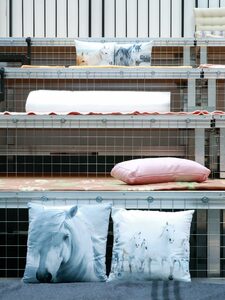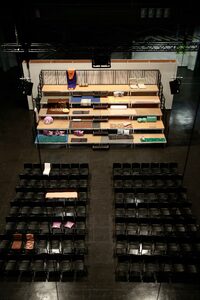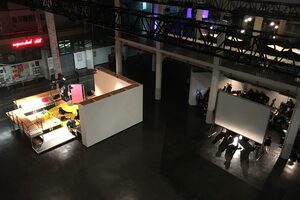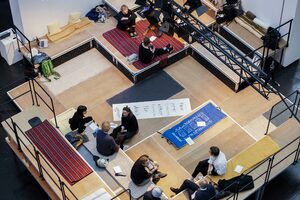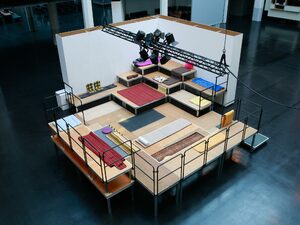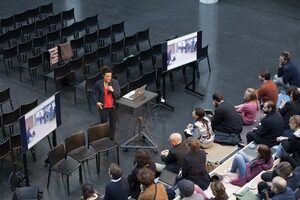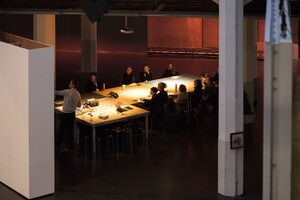Vera Gärtner
| Name | Vera Gärtner |
9 Inhalte
- Seite 1 von 1
Matters of Communication
- Titel
- Matters of Communication
- Titel (en)
- Matters of Communication
- Untertitel
- 15th annual meeting of the German Society for Design Theory and Research
- Untertitel des Projekts/Werks (en)
- 15th annual meeting of the German Society for Design Theory and Research
- Autor/in
- Beschreibung (de)
- Ob Raum, Bild, Text, Objekt oder System - Design ist immer auch Kommunikation. Vor dem Hintergrund der zunehmenden Radikalisierung, Segmentierung und Polemisierung gesellschaftlicher Diskurse scheint das Verhältnis von Design und Kommunikation heute brisanter denn je. Ständig entstehen neue Kommunikationsmedien, -kanäle, -räume und -systeme. Maschinen, Objekte, ja ganze Umgebungen werden zu eigenständigen Akteuren, die mit uns kommunizieren und auf verschiedenen medialen Ebenen interagieren. Wie können wir die Kontexte, die Möglichkeitsbedingungen und Wirkungszusammenhänge im Hinblick auf gestaltete Kommunikation ausloten? Welche Konzepte werden benötigt, um das Verhältnis von Design und Kommunikation aus heutiger Sicht zu konzeptualisieren?
Die DGTF-Konferenz "Matters of Communication" schafft einen Raum für die Diskussion darüber, wie Kommunikation heute gestaltet wird und wie Design heute kommuniziert wird. Welches sind die wegweisenden Ansätze und Methoden der Designforschung in Bezug auf Kommunikation durch und in zeitgenössischen Ausdrucksformen sowie kultureller und wirtschaftlicher Produktion? Wie reflektieren Forschungsprojekte "Matters of Communication", d.h. die Form und Materialität gestalteter Kommunikation, und ihre Rolle bei der Entstehung von Zuschreibungen und Interpretationskontexten? Welche Rolle spielt die Designforschung bei der Entwicklung von relevanten Fragestellungen und Lösungen? Wie erfolgt die Theoriebildung und Umsetzung in Lehre und Praxis?
- Ob Raum, Bild, Text, Objekt oder System - Design ist immer auch Kommunikation. Vor dem Hintergrund der zunehmenden Radikalisierung, Segmentierung und Polemisierung gesellschaftlicher Diskurse scheint das Verhältnis von Design und Kommunikation heute brisanter denn je. Ständig entstehen neue Kommunikationsmedien, -kanäle, -räume und -systeme. Maschinen, Objekte, ja ganze Umgebungen werden zu eigenständigen Akteuren, die mit uns kommunizieren und auf verschiedenen medialen Ebenen interagieren. Wie können wir die Kontexte, die Möglichkeitsbedingungen und Wirkungszusammenhänge im Hinblick auf gestaltete Kommunikation ausloten? Welche Konzepte werden benötigt, um das Verhältnis von Design und Kommunikation aus heutiger Sicht zu konzeptualisieren?
- Beschreibung (en)
- Whether space, image, text, object or system — design is always also communication. Against the backdrop of increasing radicalization, segmentation and polemization of social discourses, the relationship between design and communication seems more volatile today than ever. New communications media, channels, spaces and systems are constantly emerging. Machines, objects, even entire environments become independent actors that communicate with us and interact on various media levels. How can we sound out the contexts, the conditions that lead to possibility and the interdependencies of impact with regard to designed communication? What concepts are needed to conceptualize the relationship between design and communication from a present-day point of view?
The DGTF conference “Matters of Communication” creates a space for discussion about how communication is designed today and how design is communicated today. What are the pioneering approaches and methods of design research in relation to communication through and within contemporary forms of expression, as well as cultural and economic production? How do research projects reflect “Matters of Communication”, i.e. the form and materiality of designed communication, and their role in the emergence of attributions and interpretation contexts? What is the role that design research plays in the development of relevant questions and solutions? How is theory formation and translation into teaching and practice carried out?
- Whether space, image, text, object or system — design is always also communication. Against the backdrop of increasing radicalization, segmentation and polemization of social discourses, the relationship between design and communication seems more volatile today than ever. New communications media, channels, spaces and systems are constantly emerging. Machines, objects, even entire environments become independent actors that communicate with us and interact on various media levels. How can we sound out the contexts, the conditions that lead to possibility and the interdependencies of impact with regard to designed communication? What concepts are needed to conceptualize the relationship between design and communication from a present-day point of view?
- Typ des Projekts/Werks
- Schlagworte
- Datierung
- 16.11.2018 - 18.11.2018
- Mitwirkende
- Sprache
- Ort: Institution
- Ort
- Lichthöfe
- Stadt
- Land
- Beteiligte Institution(en)
- Internetlinks
- Bemerkungen
- Graphik-Design: Lena Haselmann and Catharina Grözinger, © DGTF
- Titel
- Matters of Communication
- Urheberrechtshinweis
- Vera Gärtner, Jana Hofmann, Calvin Kudufia
- Rechtsschutz/Lizenz
- Medienersteller/in
- Projektleiter/in
- Semester
- Lehrveranstaltung
- Importiert am
- 21.06.2023
- Übergeordnete Sets
- 1
Matters of Communication
- Titel
- Matters of Communication
- Titel (en)
- Matters of Communication
- Untertitel
- 15th annual meeting of the German Society for Design Theory and Research
- Untertitel des Projekts/Werks (en)
- 15th annual meeting of the German Society for Design Theory and Research
- Autor/in
- Beschreibung (de)
- Ob Raum, Bild, Text, Objekt oder System - Design ist immer auch Kommunikation. Vor dem Hintergrund der zunehmenden Radikalisierung, Segmentierung und Polemisierung gesellschaftlicher Diskurse scheint das Verhältnis von Design und Kommunikation heute brisanter denn je. Ständig entstehen neue Kommunikationsmedien, -kanäle, -räume und -systeme. Maschinen, Objekte, ja ganze Umgebungen werden zu eigenständigen Akteuren, die mit uns kommunizieren und auf verschiedenen medialen Ebenen interagieren. Wie können wir die Kontexte, die Möglichkeitsbedingungen und Wirkungszusammenhänge im Hinblick auf gestaltete Kommunikation ausloten? Welche Konzepte werden benötigt, um das Verhältnis von Design und Kommunikation aus heutiger Sicht zu konzeptualisieren?
Die DGTF-Konferenz "Matters of Communication" schafft einen Raum für die Diskussion darüber, wie Kommunikation heute gestaltet wird und wie Design heute kommuniziert wird. Welches sind die wegweisenden Ansätze und Methoden der Designforschung in Bezug auf Kommunikation durch und in zeitgenössischen Ausdrucksformen sowie kultureller und wirtschaftlicher Produktion? Wie reflektieren Forschungsprojekte "Matters of Communication", d.h. die Form und Materialität gestalteter Kommunikation, und ihre Rolle bei der Entstehung von Zuschreibungen und Interpretationskontexten? Welche Rolle spielt die Designforschung bei der Entwicklung von relevanten Fragestellungen und Lösungen? Wie erfolgt die Theoriebildung und Umsetzung in Lehre und Praxis?
- Ob Raum, Bild, Text, Objekt oder System - Design ist immer auch Kommunikation. Vor dem Hintergrund der zunehmenden Radikalisierung, Segmentierung und Polemisierung gesellschaftlicher Diskurse scheint das Verhältnis von Design und Kommunikation heute brisanter denn je. Ständig entstehen neue Kommunikationsmedien, -kanäle, -räume und -systeme. Maschinen, Objekte, ja ganze Umgebungen werden zu eigenständigen Akteuren, die mit uns kommunizieren und auf verschiedenen medialen Ebenen interagieren. Wie können wir die Kontexte, die Möglichkeitsbedingungen und Wirkungszusammenhänge im Hinblick auf gestaltete Kommunikation ausloten? Welche Konzepte werden benötigt, um das Verhältnis von Design und Kommunikation aus heutiger Sicht zu konzeptualisieren?
- Beschreibung (en)
- Whether space, image, text, object or system — design is always also communication. Against the backdrop of increasing radicalization, segmentation and polemization of social discourses, the relationship between design and communication seems more volatile today than ever. New communications media, channels, spaces and systems are constantly emerging. Machines, objects, even entire environments become independent actors that communicate with us and interact on various media levels. How can we sound out the contexts, the conditions that lead to possibility and the interdependencies of impact with regard to designed communication? What concepts are needed to conceptualize the relationship between design and communication from a present-day point of view?
The DGTF conference “Matters of Communication” creates a space for discussion about how communication is designed today and how design is communicated today. What are the pioneering approaches and methods of design research in relation to communication through and within contemporary forms of expression, as well as cultural and economic production? How do research projects reflect “Matters of Communication”, i.e. the form and materiality of designed communication, and their role in the emergence of attributions and interpretation contexts? What is the role that design research plays in the development of relevant questions and solutions? How is theory formation and translation into teaching and practice carried out?
- Whether space, image, text, object or system — design is always also communication. Against the backdrop of increasing radicalization, segmentation and polemization of social discourses, the relationship between design and communication seems more volatile today than ever. New communications media, channels, spaces and systems are constantly emerging. Machines, objects, even entire environments become independent actors that communicate with us and interact on various media levels. How can we sound out the contexts, the conditions that lead to possibility and the interdependencies of impact with regard to designed communication? What concepts are needed to conceptualize the relationship between design and communication from a present-day point of view?
- Typ des Projekts/Werks
- Schlagworte
- Datierung
- 16.11.2018 - 18.11.2018
- Mitwirkende
- Sprache
- Ort: Institution
- Ort
- Lichthöfe
- Stadt
- Land
- Beteiligte Institution(en)
- Internetlinks
- Bemerkungen
- Graphik-Design: Lena Haselmann and Catharina Grözinger, © DGTF
- Titel
- Matters of Communication
- Urheberrechtshinweis
- Vera Gärtner, Jana Hofmann, Calvin Kudufia
- Rechtsschutz/Lizenz
- Medienersteller/in
- Projektleiter/in
- Semester
- Lehrveranstaltung
- Importiert am
- 21.06.2023
- Übergeordnete Sets
- 1
Matters of Communication
- Titel
- Matters of Communication
- Titel (en)
- Matters of Communication
- Untertitel
- 15th annual meeting of the German Society for Design Theory and Research
- Untertitel des Projekts/Werks (en)
- 15th annual meeting of the German Society for Design Theory and Research
- Autor/in
- Beschreibung (de)
- Ob Raum, Bild, Text, Objekt oder System - Design ist immer auch Kommunikation. Vor dem Hintergrund der zunehmenden Radikalisierung, Segmentierung und Polemisierung gesellschaftlicher Diskurse scheint das Verhältnis von Design und Kommunikation heute brisanter denn je. Ständig entstehen neue Kommunikationsmedien, -kanäle, -räume und -systeme. Maschinen, Objekte, ja ganze Umgebungen werden zu eigenständigen Akteuren, die mit uns kommunizieren und auf verschiedenen medialen Ebenen interagieren. Wie können wir die Kontexte, die Möglichkeitsbedingungen und Wirkungszusammenhänge im Hinblick auf gestaltete Kommunikation ausloten? Welche Konzepte werden benötigt, um das Verhältnis von Design und Kommunikation aus heutiger Sicht zu konzeptualisieren?
Die DGTF-Konferenz "Matters of Communication" schafft einen Raum für die Diskussion darüber, wie Kommunikation heute gestaltet wird und wie Design heute kommuniziert wird. Welches sind die wegweisenden Ansätze und Methoden der Designforschung in Bezug auf Kommunikation durch und in zeitgenössischen Ausdrucksformen sowie kultureller und wirtschaftlicher Produktion? Wie reflektieren Forschungsprojekte "Matters of Communication", d.h. die Form und Materialität gestalteter Kommunikation, und ihre Rolle bei der Entstehung von Zuschreibungen und Interpretationskontexten? Welche Rolle spielt die Designforschung bei der Entwicklung von relevanten Fragestellungen und Lösungen? Wie erfolgt die Theoriebildung und Umsetzung in Lehre und Praxis?
- Ob Raum, Bild, Text, Objekt oder System - Design ist immer auch Kommunikation. Vor dem Hintergrund der zunehmenden Radikalisierung, Segmentierung und Polemisierung gesellschaftlicher Diskurse scheint das Verhältnis von Design und Kommunikation heute brisanter denn je. Ständig entstehen neue Kommunikationsmedien, -kanäle, -räume und -systeme. Maschinen, Objekte, ja ganze Umgebungen werden zu eigenständigen Akteuren, die mit uns kommunizieren und auf verschiedenen medialen Ebenen interagieren. Wie können wir die Kontexte, die Möglichkeitsbedingungen und Wirkungszusammenhänge im Hinblick auf gestaltete Kommunikation ausloten? Welche Konzepte werden benötigt, um das Verhältnis von Design und Kommunikation aus heutiger Sicht zu konzeptualisieren?
- Beschreibung (en)
- Whether space, image, text, object or system — design is always also communication. Against the backdrop of increasing radicalization, segmentation and polemization of social discourses, the relationship between design and communication seems more volatile today than ever. New communications media, channels, spaces and systems are constantly emerging. Machines, objects, even entire environments become independent actors that communicate with us and interact on various media levels. How can we sound out the contexts, the conditions that lead to possibility and the interdependencies of impact with regard to designed communication? What concepts are needed to conceptualize the relationship between design and communication from a present-day point of view?
The DGTF conference “Matters of Communication” creates a space for discussion about how communication is designed today and how design is communicated today. What are the pioneering approaches and methods of design research in relation to communication through and within contemporary forms of expression, as well as cultural and economic production? How do research projects reflect “Matters of Communication”, i.e. the form and materiality of designed communication, and their role in the emergence of attributions and interpretation contexts? What is the role that design research plays in the development of relevant questions and solutions? How is theory formation and translation into teaching and practice carried out?
- Whether space, image, text, object or system — design is always also communication. Against the backdrop of increasing radicalization, segmentation and polemization of social discourses, the relationship between design and communication seems more volatile today than ever. New communications media, channels, spaces and systems are constantly emerging. Machines, objects, even entire environments become independent actors that communicate with us and interact on various media levels. How can we sound out the contexts, the conditions that lead to possibility and the interdependencies of impact with regard to designed communication? What concepts are needed to conceptualize the relationship between design and communication from a present-day point of view?
- Typ des Projekts/Werks
- Schlagworte
- Datierung
- 16.11.2018 - 18.11.2018
- Mitwirkende
- Sprache
- Ort: Institution
- Ort
- Lichthöfe
- Stadt
- Land
- Beteiligte Institution(en)
- Internetlinks
- Bemerkungen
- Graphik-Design: Lena Haselmann and Catharina Grözinger, © DGTF
- Titel
- Matters of Communication
- Urheberrechtshinweis
- Vera Gärtner, Jana Hofmann, Calvin Kudufia
- Rechtsschutz/Lizenz
- Medienersteller/in
- Projektleiter/in
- Semester
- Lehrveranstaltung
- Importiert am
- 21.06.2023
- Übergeordnete Sets
- 1
Matters of Communication
- Titel
- Matters of Communication
- Titel (en)
- Matters of Communication
- Untertitel
- 15th annual meeting of the German Society for Design Theory and Research
- Untertitel des Projekts/Werks (en)
- 15th annual meeting of the German Society for Design Theory and Research
- Autor/in
- Beschreibung (de)
- Ob Raum, Bild, Text, Objekt oder System - Design ist immer auch Kommunikation. Vor dem Hintergrund der zunehmenden Radikalisierung, Segmentierung und Polemisierung gesellschaftlicher Diskurse scheint das Verhältnis von Design und Kommunikation heute brisanter denn je. Ständig entstehen neue Kommunikationsmedien, -kanäle, -räume und -systeme. Maschinen, Objekte, ja ganze Umgebungen werden zu eigenständigen Akteuren, die mit uns kommunizieren und auf verschiedenen medialen Ebenen interagieren. Wie können wir die Kontexte, die Möglichkeitsbedingungen und Wirkungszusammenhänge im Hinblick auf gestaltete Kommunikation ausloten? Welche Konzepte werden benötigt, um das Verhältnis von Design und Kommunikation aus heutiger Sicht zu konzeptualisieren?
Die DGTF-Konferenz "Matters of Communication" schafft einen Raum für die Diskussion darüber, wie Kommunikation heute gestaltet wird und wie Design heute kommuniziert wird. Welches sind die wegweisenden Ansätze und Methoden der Designforschung in Bezug auf Kommunikation durch und in zeitgenössischen Ausdrucksformen sowie kultureller und wirtschaftlicher Produktion? Wie reflektieren Forschungsprojekte "Matters of Communication", d.h. die Form und Materialität gestalteter Kommunikation, und ihre Rolle bei der Entstehung von Zuschreibungen und Interpretationskontexten? Welche Rolle spielt die Designforschung bei der Entwicklung von relevanten Fragestellungen und Lösungen? Wie erfolgt die Theoriebildung und Umsetzung in Lehre und Praxis?
- Ob Raum, Bild, Text, Objekt oder System - Design ist immer auch Kommunikation. Vor dem Hintergrund der zunehmenden Radikalisierung, Segmentierung und Polemisierung gesellschaftlicher Diskurse scheint das Verhältnis von Design und Kommunikation heute brisanter denn je. Ständig entstehen neue Kommunikationsmedien, -kanäle, -räume und -systeme. Maschinen, Objekte, ja ganze Umgebungen werden zu eigenständigen Akteuren, die mit uns kommunizieren und auf verschiedenen medialen Ebenen interagieren. Wie können wir die Kontexte, die Möglichkeitsbedingungen und Wirkungszusammenhänge im Hinblick auf gestaltete Kommunikation ausloten? Welche Konzepte werden benötigt, um das Verhältnis von Design und Kommunikation aus heutiger Sicht zu konzeptualisieren?
- Beschreibung (en)
- Whether space, image, text, object or system — design is always also communication. Against the backdrop of increasing radicalization, segmentation and polemization of social discourses, the relationship between design and communication seems more volatile today than ever. New communications media, channels, spaces and systems are constantly emerging. Machines, objects, even entire environments become independent actors that communicate with us and interact on various media levels. How can we sound out the contexts, the conditions that lead to possibility and the interdependencies of impact with regard to designed communication? What concepts are needed to conceptualize the relationship between design and communication from a present-day point of view?
The DGTF conference “Matters of Communication” creates a space for discussion about how communication is designed today and how design is communicated today. What are the pioneering approaches and methods of design research in relation to communication through and within contemporary forms of expression, as well as cultural and economic production? How do research projects reflect “Matters of Communication”, i.e. the form and materiality of designed communication, and their role in the emergence of attributions and interpretation contexts? What is the role that design research plays in the development of relevant questions and solutions? How is theory formation and translation into teaching and practice carried out?
- Whether space, image, text, object or system — design is always also communication. Against the backdrop of increasing radicalization, segmentation and polemization of social discourses, the relationship between design and communication seems more volatile today than ever. New communications media, channels, spaces and systems are constantly emerging. Machines, objects, even entire environments become independent actors that communicate with us and interact on various media levels. How can we sound out the contexts, the conditions that lead to possibility and the interdependencies of impact with regard to designed communication? What concepts are needed to conceptualize the relationship between design and communication from a present-day point of view?
- Typ des Projekts/Werks
- Schlagworte
- Datierung
- 16.11.2018 - 18.11.2018
- Mitwirkende
- Sprache
- Ort: Institution
- Ort
- Lichthöfe
- Stadt
- Land
- Beteiligte Institution(en)
- Internetlinks
- Bemerkungen
- Graphik-Design: Lena Haselmann and Catharina Grözinger, © DGTF
- Titel
- Matters of Communication
- Urheberrechtshinweis
- Vera Gärtner, Jana Hofmann, Calvin Kudufia
- Rechtsschutz/Lizenz
- Medienersteller/in
- Projektleiter/in
- Semester
- Lehrveranstaltung
- Importiert am
- 21.06.2023
- Übergeordnete Sets
- 1
Matters of Communication
- Titel
- Matters of Communication
- Titel (en)
- Matters of Communication
- Untertitel
- 15th annual meeting of the German Society for Design Theory and Research
- Untertitel des Projekts/Werks (en)
- 15th annual meeting of the German Society for Design Theory and Research
- Autor/in
- Beschreibung (de)
- Ob Raum, Bild, Text, Objekt oder System - Design ist immer auch Kommunikation. Vor dem Hintergrund der zunehmenden Radikalisierung, Segmentierung und Polemisierung gesellschaftlicher Diskurse scheint das Verhältnis von Design und Kommunikation heute brisanter denn je. Ständig entstehen neue Kommunikationsmedien, -kanäle, -räume und -systeme. Maschinen, Objekte, ja ganze Umgebungen werden zu eigenständigen Akteuren, die mit uns kommunizieren und auf verschiedenen medialen Ebenen interagieren. Wie können wir die Kontexte, die Möglichkeitsbedingungen und Wirkungszusammenhänge im Hinblick auf gestaltete Kommunikation ausloten? Welche Konzepte werden benötigt, um das Verhältnis von Design und Kommunikation aus heutiger Sicht zu konzeptualisieren?
Die DGTF-Konferenz "Matters of Communication" schafft einen Raum für die Diskussion darüber, wie Kommunikation heute gestaltet wird und wie Design heute kommuniziert wird. Welches sind die wegweisenden Ansätze und Methoden der Designforschung in Bezug auf Kommunikation durch und in zeitgenössischen Ausdrucksformen sowie kultureller und wirtschaftlicher Produktion? Wie reflektieren Forschungsprojekte "Matters of Communication", d.h. die Form und Materialität gestalteter Kommunikation, und ihre Rolle bei der Entstehung von Zuschreibungen und Interpretationskontexten? Welche Rolle spielt die Designforschung bei der Entwicklung von relevanten Fragestellungen und Lösungen? Wie erfolgt die Theoriebildung und Umsetzung in Lehre und Praxis?
- Ob Raum, Bild, Text, Objekt oder System - Design ist immer auch Kommunikation. Vor dem Hintergrund der zunehmenden Radikalisierung, Segmentierung und Polemisierung gesellschaftlicher Diskurse scheint das Verhältnis von Design und Kommunikation heute brisanter denn je. Ständig entstehen neue Kommunikationsmedien, -kanäle, -räume und -systeme. Maschinen, Objekte, ja ganze Umgebungen werden zu eigenständigen Akteuren, die mit uns kommunizieren und auf verschiedenen medialen Ebenen interagieren. Wie können wir die Kontexte, die Möglichkeitsbedingungen und Wirkungszusammenhänge im Hinblick auf gestaltete Kommunikation ausloten? Welche Konzepte werden benötigt, um das Verhältnis von Design und Kommunikation aus heutiger Sicht zu konzeptualisieren?
- Beschreibung (en)
- Whether space, image, text, object or system — design is always also communication. Against the backdrop of increasing radicalization, segmentation and polemization of social discourses, the relationship between design and communication seems more volatile today than ever. New communications media, channels, spaces and systems are constantly emerging. Machines, objects, even entire environments become independent actors that communicate with us and interact on various media levels. How can we sound out the contexts, the conditions that lead to possibility and the interdependencies of impact with regard to designed communication? What concepts are needed to conceptualize the relationship between design and communication from a present-day point of view?
The DGTF conference “Matters of Communication” creates a space for discussion about how communication is designed today and how design is communicated today. What are the pioneering approaches and methods of design research in relation to communication through and within contemporary forms of expression, as well as cultural and economic production? How do research projects reflect “Matters of Communication”, i.e. the form and materiality of designed communication, and their role in the emergence of attributions and interpretation contexts? What is the role that design research plays in the development of relevant questions and solutions? How is theory formation and translation into teaching and practice carried out?
- Whether space, image, text, object or system — design is always also communication. Against the backdrop of increasing radicalization, segmentation and polemization of social discourses, the relationship between design and communication seems more volatile today than ever. New communications media, channels, spaces and systems are constantly emerging. Machines, objects, even entire environments become independent actors that communicate with us and interact on various media levels. How can we sound out the contexts, the conditions that lead to possibility and the interdependencies of impact with regard to designed communication? What concepts are needed to conceptualize the relationship between design and communication from a present-day point of view?
- Typ des Projekts/Werks
- Schlagworte
- Datierung
- 16.11.2018 - 18.11.2018
- Mitwirkende
- Sprache
- Ort: Institution
- Ort
- Lichthöfe
- Stadt
- Land
- Beteiligte Institution(en)
- Internetlinks
- Bemerkungen
- Graphik-Design: Lena Haselmann and Catharina Grözinger, © DGTF
- Titel
- Matters of Communication
- Urheberrechtshinweis
- Vera Gärtner, Jana Hofmann, Calvin Kudufia
- Rechtsschutz/Lizenz
- Medienersteller/in
- Projektleiter/in
- Semester
- Lehrveranstaltung
- Importiert am
- 21.06.2023
- Übergeordnete Sets
- 1
Matters of Communication
- Titel
- Matters of Communication
- Titel (en)
- Matters of Communication
- Untertitel
- 15th annual meeting of the German Society for Design Theory and Research
- Untertitel des Projekts/Werks (en)
- 15th annual meeting of the German Society for Design Theory and Research
- Autor/in
- Beschreibung (de)
- Ob Raum, Bild, Text, Objekt oder System - Design ist immer auch Kommunikation. Vor dem Hintergrund der zunehmenden Radikalisierung, Segmentierung und Polemisierung gesellschaftlicher Diskurse scheint das Verhältnis von Design und Kommunikation heute brisanter denn je. Ständig entstehen neue Kommunikationsmedien, -kanäle, -räume und -systeme. Maschinen, Objekte, ja ganze Umgebungen werden zu eigenständigen Akteuren, die mit uns kommunizieren und auf verschiedenen medialen Ebenen interagieren. Wie können wir die Kontexte, die Möglichkeitsbedingungen und Wirkungszusammenhänge im Hinblick auf gestaltete Kommunikation ausloten? Welche Konzepte werden benötigt, um das Verhältnis von Design und Kommunikation aus heutiger Sicht zu konzeptualisieren?
Die DGTF-Konferenz "Matters of Communication" schafft einen Raum für die Diskussion darüber, wie Kommunikation heute gestaltet wird und wie Design heute kommuniziert wird. Welches sind die wegweisenden Ansätze und Methoden der Designforschung in Bezug auf Kommunikation durch und in zeitgenössischen Ausdrucksformen sowie kultureller und wirtschaftlicher Produktion? Wie reflektieren Forschungsprojekte "Matters of Communication", d.h. die Form und Materialität gestalteter Kommunikation, und ihre Rolle bei der Entstehung von Zuschreibungen und Interpretationskontexten? Welche Rolle spielt die Designforschung bei der Entwicklung von relevanten Fragestellungen und Lösungen? Wie erfolgt die Theoriebildung und Umsetzung in Lehre und Praxis?
- Ob Raum, Bild, Text, Objekt oder System - Design ist immer auch Kommunikation. Vor dem Hintergrund der zunehmenden Radikalisierung, Segmentierung und Polemisierung gesellschaftlicher Diskurse scheint das Verhältnis von Design und Kommunikation heute brisanter denn je. Ständig entstehen neue Kommunikationsmedien, -kanäle, -räume und -systeme. Maschinen, Objekte, ja ganze Umgebungen werden zu eigenständigen Akteuren, die mit uns kommunizieren und auf verschiedenen medialen Ebenen interagieren. Wie können wir die Kontexte, die Möglichkeitsbedingungen und Wirkungszusammenhänge im Hinblick auf gestaltete Kommunikation ausloten? Welche Konzepte werden benötigt, um das Verhältnis von Design und Kommunikation aus heutiger Sicht zu konzeptualisieren?
- Beschreibung (en)
- Whether space, image, text, object or system — design is always also communication. Against the backdrop of increasing radicalization, segmentation and polemization of social discourses, the relationship between design and communication seems more volatile today than ever. New communications media, channels, spaces and systems are constantly emerging. Machines, objects, even entire environments become independent actors that communicate with us and interact on various media levels. How can we sound out the contexts, the conditions that lead to possibility and the interdependencies of impact with regard to designed communication? What concepts are needed to conceptualize the relationship between design and communication from a present-day point of view?
The DGTF conference “Matters of Communication” creates a space for discussion about how communication is designed today and how design is communicated today. What are the pioneering approaches and methods of design research in relation to communication through and within contemporary forms of expression, as well as cultural and economic production? How do research projects reflect “Matters of Communication”, i.e. the form and materiality of designed communication, and their role in the emergence of attributions and interpretation contexts? What is the role that design research plays in the development of relevant questions and solutions? How is theory formation and translation into teaching and practice carried out?
- Whether space, image, text, object or system — design is always also communication. Against the backdrop of increasing radicalization, segmentation and polemization of social discourses, the relationship between design and communication seems more volatile today than ever. New communications media, channels, spaces and systems are constantly emerging. Machines, objects, even entire environments become independent actors that communicate with us and interact on various media levels. How can we sound out the contexts, the conditions that lead to possibility and the interdependencies of impact with regard to designed communication? What concepts are needed to conceptualize the relationship between design and communication from a present-day point of view?
- Typ des Projekts/Werks
- Schlagworte
- Datierung
- 16.11.2018 - 18.11.2018
- Mitwirkende
- Sprache
- Ort: Institution
- Ort
- Lichthöfe
- Stadt
- Land
- Beteiligte Institution(en)
- Internetlinks
- Bemerkungen
- Graphik-Design: Lena Haselmann and Catharina Grözinger, © DGTF
- Titel
- Matters of Communication
- Urheberrechtshinweis
- Vera Gärtner, Jana Hofmann, Calvin Kudufia
- Rechtsschutz/Lizenz
- Medienersteller/in
- Projektleiter/in
- Semester
- Lehrveranstaltung
- Importiert am
- 21.06.2023
- Übergeordnete Sets
- 1
Matters of Communication
- Titel
- Matters of Communication
- Titel (en)
- Matters of Communication
- Untertitel
- 15th annual meeting of the German Society for Design Theory and Research
- Untertitel des Projekts/Werks (en)
- 15th annual meeting of the German Society for Design Theory and Research
- Autor/in
- Beschreibung (de)
- Ob Raum, Bild, Text, Objekt oder System - Design ist immer auch Kommunikation. Vor dem Hintergrund der zunehmenden Radikalisierung, Segmentierung und Polemisierung gesellschaftlicher Diskurse scheint das Verhältnis von Design und Kommunikation heute brisanter denn je. Ständig entstehen neue Kommunikationsmedien, -kanäle, -räume und -systeme. Maschinen, Objekte, ja ganze Umgebungen werden zu eigenständigen Akteuren, die mit uns kommunizieren und auf verschiedenen medialen Ebenen interagieren. Wie können wir die Kontexte, die Möglichkeitsbedingungen und Wirkungszusammenhänge im Hinblick auf gestaltete Kommunikation ausloten? Welche Konzepte werden benötigt, um das Verhältnis von Design und Kommunikation aus heutiger Sicht zu konzeptualisieren?
Die DGTF-Konferenz "Matters of Communication" schafft einen Raum für die Diskussion darüber, wie Kommunikation heute gestaltet wird und wie Design heute kommuniziert wird. Welches sind die wegweisenden Ansätze und Methoden der Designforschung in Bezug auf Kommunikation durch und in zeitgenössischen Ausdrucksformen sowie kultureller und wirtschaftlicher Produktion? Wie reflektieren Forschungsprojekte "Matters of Communication", d.h. die Form und Materialität gestalteter Kommunikation, und ihre Rolle bei der Entstehung von Zuschreibungen und Interpretationskontexten? Welche Rolle spielt die Designforschung bei der Entwicklung von relevanten Fragestellungen und Lösungen? Wie erfolgt die Theoriebildung und Umsetzung in Lehre und Praxis?
- Ob Raum, Bild, Text, Objekt oder System - Design ist immer auch Kommunikation. Vor dem Hintergrund der zunehmenden Radikalisierung, Segmentierung und Polemisierung gesellschaftlicher Diskurse scheint das Verhältnis von Design und Kommunikation heute brisanter denn je. Ständig entstehen neue Kommunikationsmedien, -kanäle, -räume und -systeme. Maschinen, Objekte, ja ganze Umgebungen werden zu eigenständigen Akteuren, die mit uns kommunizieren und auf verschiedenen medialen Ebenen interagieren. Wie können wir die Kontexte, die Möglichkeitsbedingungen und Wirkungszusammenhänge im Hinblick auf gestaltete Kommunikation ausloten? Welche Konzepte werden benötigt, um das Verhältnis von Design und Kommunikation aus heutiger Sicht zu konzeptualisieren?
- Beschreibung (en)
- Whether space, image, text, object or system — design is always also communication. Against the backdrop of increasing radicalization, segmentation and polemization of social discourses, the relationship between design and communication seems more volatile today than ever. New communications media, channels, spaces and systems are constantly emerging. Machines, objects, even entire environments become independent actors that communicate with us and interact on various media levels. How can we sound out the contexts, the conditions that lead to possibility and the interdependencies of impact with regard to designed communication? What concepts are needed to conceptualize the relationship between design and communication from a present-day point of view?
The DGTF conference “Matters of Communication” creates a space for discussion about how communication is designed today and how design is communicated today. What are the pioneering approaches and methods of design research in relation to communication through and within contemporary forms of expression, as well as cultural and economic production? How do research projects reflect “Matters of Communication”, i.e. the form and materiality of designed communication, and their role in the emergence of attributions and interpretation contexts? What is the role that design research plays in the development of relevant questions and solutions? How is theory formation and translation into teaching and practice carried out?
- Whether space, image, text, object or system — design is always also communication. Against the backdrop of increasing radicalization, segmentation and polemization of social discourses, the relationship between design and communication seems more volatile today than ever. New communications media, channels, spaces and systems are constantly emerging. Machines, objects, even entire environments become independent actors that communicate with us and interact on various media levels. How can we sound out the contexts, the conditions that lead to possibility and the interdependencies of impact with regard to designed communication? What concepts are needed to conceptualize the relationship between design and communication from a present-day point of view?
- Typ des Projekts/Werks
- Schlagworte
- Datierung
- 16.11.2018 - 18.11.2018
- Mitwirkende
- Sprache
- Ort: Institution
- Ort
- Lichthöfe
- Stadt
- Land
- Beteiligte Institution(en)
- Internetlinks
- Bemerkungen
- Graphik-Design: Lena Haselmann and Catharina Grözinger, © DGTF
- Titel
- Matters of Communication
- Urheberrechtshinweis
- Vera Gärtner, Jana Hofmann, Calvin Kudufia
- Rechtsschutz/Lizenz
- Medienersteller/in
- Projektleiter/in
- Semester
- Lehrveranstaltung
- Importiert am
- 21.06.2023
- Übergeordnete Sets
- 1
Matters of Communication
- Titel
- Matters of Communication
- Titel (en)
- Matters of Communication
- Untertitel
- 15th annual meeting of the German Society for Design Theory and Research
- Untertitel des Projekts/Werks (en)
- 15th annual meeting of the German Society for Design Theory and Research
- Autor/in
- Beschreibung (de)
- Ob Raum, Bild, Text, Objekt oder System - Design ist immer auch Kommunikation. Vor dem Hintergrund der zunehmenden Radikalisierung, Segmentierung und Polemisierung gesellschaftlicher Diskurse scheint das Verhältnis von Design und Kommunikation heute brisanter denn je. Ständig entstehen neue Kommunikationsmedien, -kanäle, -räume und -systeme. Maschinen, Objekte, ja ganze Umgebungen werden zu eigenständigen Akteuren, die mit uns kommunizieren und auf verschiedenen medialen Ebenen interagieren. Wie können wir die Kontexte, die Möglichkeitsbedingungen und Wirkungszusammenhänge im Hinblick auf gestaltete Kommunikation ausloten? Welche Konzepte werden benötigt, um das Verhältnis von Design und Kommunikation aus heutiger Sicht zu konzeptualisieren?
Die DGTF-Konferenz "Matters of Communication" schafft einen Raum für die Diskussion darüber, wie Kommunikation heute gestaltet wird und wie Design heute kommuniziert wird. Welches sind die wegweisenden Ansätze und Methoden der Designforschung in Bezug auf Kommunikation durch und in zeitgenössischen Ausdrucksformen sowie kultureller und wirtschaftlicher Produktion? Wie reflektieren Forschungsprojekte "Matters of Communication", d.h. die Form und Materialität gestalteter Kommunikation, und ihre Rolle bei der Entstehung von Zuschreibungen und Interpretationskontexten? Welche Rolle spielt die Designforschung bei der Entwicklung von relevanten Fragestellungen und Lösungen? Wie erfolgt die Theoriebildung und Umsetzung in Lehre und Praxis?
- Ob Raum, Bild, Text, Objekt oder System - Design ist immer auch Kommunikation. Vor dem Hintergrund der zunehmenden Radikalisierung, Segmentierung und Polemisierung gesellschaftlicher Diskurse scheint das Verhältnis von Design und Kommunikation heute brisanter denn je. Ständig entstehen neue Kommunikationsmedien, -kanäle, -räume und -systeme. Maschinen, Objekte, ja ganze Umgebungen werden zu eigenständigen Akteuren, die mit uns kommunizieren und auf verschiedenen medialen Ebenen interagieren. Wie können wir die Kontexte, die Möglichkeitsbedingungen und Wirkungszusammenhänge im Hinblick auf gestaltete Kommunikation ausloten? Welche Konzepte werden benötigt, um das Verhältnis von Design und Kommunikation aus heutiger Sicht zu konzeptualisieren?
- Beschreibung (en)
- Whether space, image, text, object or system — design is always also communication. Against the backdrop of increasing radicalization, segmentation and polemization of social discourses, the relationship between design and communication seems more volatile today than ever. New communications media, channels, spaces and systems are constantly emerging. Machines, objects, even entire environments become independent actors that communicate with us and interact on various media levels. How can we sound out the contexts, the conditions that lead to possibility and the interdependencies of impact with regard to designed communication? What concepts are needed to conceptualize the relationship between design and communication from a present-day point of view?
The DGTF conference “Matters of Communication” creates a space for discussion about how communication is designed today and how design is communicated today. What are the pioneering approaches and methods of design research in relation to communication through and within contemporary forms of expression, as well as cultural and economic production? How do research projects reflect “Matters of Communication”, i.e. the form and materiality of designed communication, and their role in the emergence of attributions and interpretation contexts? What is the role that design research plays in the development of relevant questions and solutions? How is theory formation and translation into teaching and practice carried out?
- Whether space, image, text, object or system — design is always also communication. Against the backdrop of increasing radicalization, segmentation and polemization of social discourses, the relationship between design and communication seems more volatile today than ever. New communications media, channels, spaces and systems are constantly emerging. Machines, objects, even entire environments become independent actors that communicate with us and interact on various media levels. How can we sound out the contexts, the conditions that lead to possibility and the interdependencies of impact with regard to designed communication? What concepts are needed to conceptualize the relationship between design and communication from a present-day point of view?
- Typ des Projekts/Werks
- Schlagworte
- Datierung
- 16.11.2018 - 18.11.2018
- Mitwirkende
- Sprache
- Ort: Institution
- Ort
- Lichthöfe
- Stadt
- Land
- Beteiligte Institution(en)
- Internetlinks
- Bemerkungen
- Graphik-Design: Lena Haselmann and Catharina Grözinger, © DGTF
- Titel
- Matters of Communication
- Urheberrechtshinweis
- Vera Gärtner, Jana Hofmann, Calvin Kudufia
- Rechtsschutz/Lizenz
- Medienersteller/in
- Projektleiter/in
- Semester
- Lehrveranstaltung
- Importiert am
- 21.06.2023
- Übergeordnete Sets
- 1
Disparate Precedents of Display
- Titel
- Disparate Precedents of Display
- Titel (en)
- Disparate Precedents of Display
- Untertitel
- A Footnote
- Untertitel des Projekts/Werks (en)
- A Footnote
- Autor/in
- Beschreibung (de)
- Das Projekt befasst sich mit den politischen Dimensionen der Ausstellungsgestaltung und führt durch zwei vom Architekten Egon Eiermann gestaltete Ausstellungen. Es erforscht die Verschränkung von Design und Politik, Nationalsozialismus und Formen der Repräsentation.
"Disparate Precedents of Display" untersucht die Art und Weise, wie der Raum auf die Besucher wirkt, und stellt Ausstellungsdesign als eine genuin politische Praxis dar, die auf der Vergangenheit aufbaut und von ihr erbt - von vergangenen Ausstellungen, einflussreichen Ausstellungsgestalter*innen und Konventionen der Präsentation, die in unterschiedlichen politischen Systemen wurzeln.
Zwei Ausstellungen, die vom deutschen Staat in Auftrag gegeben wurden, dienen als Fallstudien. "Gebt mir vier Jahre Zeit" war eine nationalsozialistische Propagandaschau, die 1937 in Berlin stattfand. Sie feierte die Umgestaltung aller Bereiche der Gesellschaft unter der nationalsozialistischen Herrschaft seit der Umsetzung von Adolf Hitlers Vierjahresplan. Einundzwanzig Jahre später beauftragte die Bundesrepublik Deutschland denselben Architekten mit der Gestaltung des deutschen Pavillons auf der Expo '58 in Brüssel. Auf der Weltausstellung hatte der junge Nachfolgestaat zum ersten Mal die Gelegenheit, die kulturellen, wirtschaftlichen und politischen Parameter des nunmehr demokratischen Deutschlands auf internationaler Ebene zu präsentieren. Beide Ausstellungen lassen sich als Repräsentationen staatlicher Macht und politischer Narrative beschreiben - die eine im Namen des Krieges, die andere im Namen der Humanität. Maßgeblich beteiligt an beiden Ausstellungen war Egon Eiermann als Ausstellungsarchitekt.
Performance: Anna K. Seidel
Outside Eye: Caroline Kapp, Manon Haase
Graphikdesign: Mona Mayer
Single line font EE_7475: Barbara Acevedo Strange, Moritz Appich
Coding: Frank Bublitz
Stimme: Liv Rahel Schwenk
Aufzeichnung: Florian Wulff
Video Dokumentation: Mustafa Emin Büyükcoşkun
Photographien: Lizzy Ellbrück
Editorial support: Joyce Moore
Copyediting: George MacBeth
Special Thanks to
Céline Condorelli, Hanne König, Sami Khatib, Lioudmila Voropai,
Julian Warner, Thomas Rustemeyer, Constanze Fischbeck,
Susanne Kriemann, Hans D. Christ und Iris Dressler, Judith Milz,
Christian Becker (Stadtarchiv Oranienburg), Mechthild Ebert (saai),
Janina Capelle, Lydia Kähny, Daniel Lythgoe, Tjark Schönfeld,
Alexander Knoppik, Lena Breitmoser, Sören Göbel, Jule Köpke, Arthur Schuman,
Jana Barthel and Danny Klein.
Gefördert von
Fonds Darstellende Künste (Rechercheförderung)
Rosa Luxemburg Stiftung Baden Württemberg
- Das Projekt befasst sich mit den politischen Dimensionen der Ausstellungsgestaltung und führt durch zwei vom Architekten Egon Eiermann gestaltete Ausstellungen. Es erforscht die Verschränkung von Design und Politik, Nationalsozialismus und Formen der Repräsentation.
- Beschreibung (en)
- The project addresses the political dimensions of exhibition design, leading through
two exhibitions designed by architect Egon Eiermann. It explores the entanglement of
design and politics, National Socialism and forms of representation.
"Disparate Precedents of Display" looks at the way space affects visitors, exposing exhibition design as a genuinely political practice, building on and inheriting from the past – from past exhibitions, influential exhibition designers and conventions of display rooted in disparate political systems.
Two exhibitions, commissioned by the German state, serve as case studies. “Gebt mir vier Jahre Zeit” was a National Socialist propaganda show staged in Berlin in 1937. It celebrated the transformation of all sectors of society under National Socialist rule since the implementation of Adolf Hitlers 4-year-plan. Twenty-one years later, the Federal Republic of Germany commissioned the same architect to design the German Pavilion at the Expo ‘58 in Brussels. At the World‘s Fair the young successor state had its first opportunity to present the cultural, economic and political parameters of a now democratic Germany on an international scale. Both shows can be described as representations of state power and political narratives – one in the name of war and one in the name of humanity. Significant contributor to both exhibitions was Egon Eiermann in his role as exhibition architect.
Performance: Anna K. Seidel
Outside Eye: Caroline Kapp, Manon Haase
Graphic Design: Mona Mayer
Single line font EE_7475: Barbara Acevedo Strange, Moritz Appich
Coding: Frank Bublitz
Voice: Liv Rahel Schwenk
Recording: Florian Wulff
Video documentation: Mustafa Emin Büyükcoşkun
Photography: Lizzy Ellbrück
Editorial support: Joyce Moore
Copyediting: George MacBeth
Special Thanks to
Céline Condorelli, Hanne König, Sami Khatib, Lioudmila Voropai,
Julian Warner, Thomas Rustemeyer, Constanze Fischbeck,
Susanne Kriemann, Hans D. Christ und Iris Dressler, Judith Milz,
Christian Becker (Stadtarchiv Oranienburg), Mechthild Ebert (saai),
Janina Capelle, Lydia Kähny, Daniel Lythgoe, Tjark Schönfeld,
Alexander Knoppik, Lena Breitmoser, Sören Göbel, Jule Köpke, Arthur Schuman,
Jana Barthel and Danny Klein.
Funded by
Fonds Darstellende Künste (Rechercheförderung)
Rosa Luxemburg Stiftung Baden Württemberg
- The project addresses the political dimensions of exhibition design, leading through
- Typ des Projekts/Werks
- Schlagworte
- Datierung
- 28.07.2023
- Mitwirkende
- Dank an
- Sprache
- Dauer
- Performance: ca. 30 Minuten
- Ort
- Brauerstraße 2
- Stadt
- Land
- Titel
- Disparate Precedents of Display
- Urheberrechtshinweis
- Teresa Häußler
- Rechtsschutz/Lizenz
- Freigabe Nutzung HfG
- Medienersteller/in
- Beziehung/Funktion
- Medien-Beschreibung
- Ein Mitglied des Publikums blättert in der Broschüre.
- Medien-Beschreibung (en)
- Member of the audience scrolling through the booklet.
- Abgebildete Personen
- Projektleiter/in
- Semester
- Studiengang
- Typ der Abschlussarbeit
- Importiert am
- 28.09.2023
- Übergeordnete Sets
- 1
